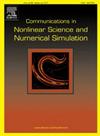An Enriched Galerkin (EG) method for multicomponent porous media flow with nonlinear coupling
IF 3.4
2区 数学
Q1 MATHEMATICS, APPLIED
Communications in Nonlinear Science and Numerical Simulation
Pub Date : 2025-02-22
DOI:10.1016/j.cnsns.2025.108613
引用次数: 0
Abstract
In this paper, we discuss fully discrete numerical methods for the multicomponent compressible single-phase Darcy flow in porous media. The new compressible pressure equation is based on the volume balance approach while considering the decomposition of the diffusion-dispersion tensor into two parts to obtain a self-consistent coupled nonlinear model. Similar to conventional approaches, the numerical decoupling of the system is through a pressure equation, which can be used to calculate the pressure and Darcy velocity by using the concentration from the previous time step. The novelty of this work is a new formulation of the consistent pressure equation based on the multicomponent setting. The conventional approach, however, typically uses a pressure equation derived from a single-pseudo-component setting, which is not consistent physically; the physical inconsistency at the PDE level also yields certain inconsistencies at the numerical discretization. The new pressure equation formulated in this work overcomes the difficulties on both the PDE level and the discretization level. We use the enriched Galerkin (EG) methods to approximate the mass conservation law of each component, followed by substitution of the discrete Darcy law to obtain a numerical discretization of the species transport equations. We then carried out a weighted summation of the species transport equations to obtain the discrete pressure equation, which gave us a self-consistent decoupling numerical scheme. At the end of this article, error analyses for semi-discrete and fully discrete cases are presented, and the theoretical conclusions are verified through numerical experiments.
求助全文
约1分钟内获得全文
求助全文
来源期刊

Communications in Nonlinear Science and Numerical Simulation
MATHEMATICS, APPLIED-MATHEMATICS, INTERDISCIPLINARY APPLICATIONS
CiteScore
6.80
自引率
7.70%
发文量
378
审稿时长
78 days
期刊介绍:
The journal publishes original research findings on experimental observation, mathematical modeling, theoretical analysis and numerical simulation, for more accurate description, better prediction or novel application, of nonlinear phenomena in science and engineering. It offers a venue for researchers to make rapid exchange of ideas and techniques in nonlinear science and complexity.
The submission of manuscripts with cross-disciplinary approaches in nonlinear science and complexity is particularly encouraged.
Topics of interest:
Nonlinear differential or delay equations, Lie group analysis and asymptotic methods, Discontinuous systems, Fractals, Fractional calculus and dynamics, Nonlinear effects in quantum mechanics, Nonlinear stochastic processes, Experimental nonlinear science, Time-series and signal analysis, Computational methods and simulations in nonlinear science and engineering, Control of dynamical systems, Synchronization, Lyapunov analysis, High-dimensional chaos and turbulence, Chaos in Hamiltonian systems, Integrable systems and solitons, Collective behavior in many-body systems, Biological physics and networks, Nonlinear mechanical systems, Complex systems and complexity.
No length limitation for contributions is set, but only concisely written manuscripts are published. Brief papers are published on the basis of Rapid Communications. Discussions of previously published papers are welcome.
 求助内容:
求助内容: 应助结果提醒方式:
应助结果提醒方式:


